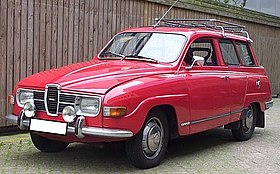
The Ford Taunus is a family car that was sold by Ford Germany throughout Europe. Models from 1970 onward were built on the same basic construction as the Ford Cortina MkIII in the United Kingdom, and later on, the two car models were essentially the same, differing almost only in the placement of the steering wheel. The model line was named after the Taunus mountain range in Germany, and was first made in 1939, and continued through several versions until 1994.
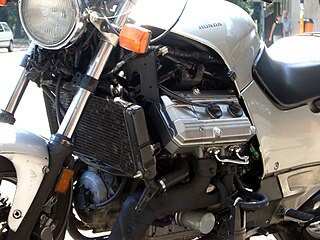
A V4 engine is a four-cylinder piston engine where the cylinders share a common crankshaft and are arranged in a V configuration.

The Saab 9-3 is a compact executive car initially developed and manufactured by the Swedish automaker Saab.

A straight-three engine is a three-cylinder piston engine where cylinders are arranged in a line along a common crankshaft.

The Saab 99 is a car produced by Swedish manufacturer Saab from 1968 to 1984; their first foray into a larger class than the Saab 96. While considered a large family car in Scandinavia, it was marketed as a niche compact executive car in most other markets. It was manufactured both in Sweden and Finland and was succeeded by the Saab 900, although the 99 continued to be produced alongside its successor. The Saab 90, an updated, less complex version using many 900 parts took over from the 99 in late 1984.

The Saab 9-5 is an executive car that was produced by the Swedish automobile maker Saab from 1997 to 2012.

The Saab 96 is an automobile manufactured and marketed by Swedish automaker Saab from 1960 to January 1980, replacing the Saab 93. The 96 featured aerodynamic two-door bodywork, four-passenger seating and at first a two-stroke, three-cylinder engine, later a four-stroke V4.

The Saab Granturismo was a series of up-powered sedans sold by Saab Automobile AB from 1958 to 1968. They were powered by three-cylinder, two-stroke engines until the 1967 model year. Most variants were distinguished from the standard model by twin metal stripes along the rocker panels.

The Saab Sonett is an automobile manufactured by Swedish automaker Saab between 1955 and 1957 and again between 1966 and 1974. Sonetts share engines and other components with Saab 93, 95 and 96 of the same era. It was mainly intended for the lucrative American export market and was only offered intermittently in the Swedish domestic market.

The Dodge Dynasty is a mid-size four-door sedan that was marketed by the Dodge division of Chrysler Corporation from 1988 until 1993 model years. Serving as the direct successor of the Dodge 600 sedan, the Dynasty was slotted between the Dodge Spirit and Dodge Monaco in the Dodge sedan line.
The name Ford Corsair was used both for a car produced by Ford of Britain between 1963 and 1970, and for an unrelated Nissan-based automobile marketed by Ford Australia between 1989 and 1992.

Saab Automobile AB was a car manufacturer that was founded in Sweden in 1945 when its parent company, Saab AB, began a project to design a small automobile. The first production model, the Saab 92, was launched in 1949. In 1968 the parent company merged with Scania-Vabis, and ten years later the Saab 900 was launched, in time becoming Saab's best-selling model. In the mid-1980s the new Saab 9000 model also appeared.
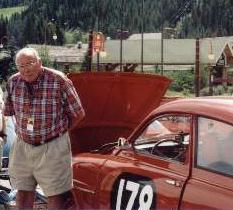
Erik Hilding Carlsson was a Swedish rally driver for Saab. He was nicknamed "Carlsson på taket" as well as Mr. Saab.

The Ford Taunus V4 engine is a 60° V4 piston engine with one balance shaft, introduced by Ford Motor Company in Germany in 1962. The German V4 was built in the Cologne plant and powered the Ford Taunus and German versions of the Consul, Capri, and Transit.

The Saab two-stroke was a two-stroke cycle, inline, two cylinder, and later three cylinder engine manufactured by Swedish automotive manufacturer Saab that was based on a design by German manufacturer DKW.
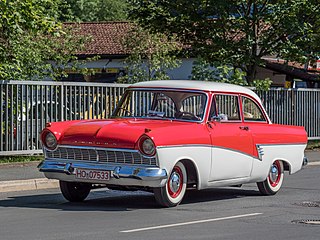
The Ford Taunus 17 M is a middle sized family saloon/sedan that was produced by Ford Germany between August 1957 and August 1960. The Taunus 17M name was also applied to subsequent Ford models which is why the car is usually identified, in retrospect, as the Ford Taunus P2. It was the second newly designed German Ford to be launched after the war and for this reason it was from inception known within the company as Ford Project 2 (P2) or the Ford Taunus P2.

The Ford Taunus 12M is a small family car that was produced by Ford Germany between September 1962 and August 1966.
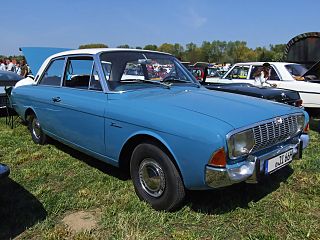
The Ford Taunus 17 M is a middle-weight family saloon/sedan that was produced by Ford Germany between 1964 and 1967. The entire range was first presented in September 1964 and volume production of the two and four door saloons/sedans began in November 1964. The "Turnier" version followed in January 1965 with coupé bodied cars coming along some time later.
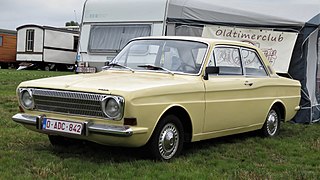
The Ford Taunus 12 M is a range of large family saloons/sedans that were produced by Ford Germany between 1966 and 1970. There were two different engine sizes in the 12M. Two larger engines were available in the otherwise very similar Ford Taunus 15 M. From the outside the 15M was differentiated by its grill and rectangular headlights from the 12M which had round front lights. A complicating feature was the availability, at extra cost, of one of the larger engines from the 15M in the 12M.

The Ford P7 is a range of large family saloons/sedans produced by Ford Germany between autumn 1967 and December 1971. The P7 was marketed as the Ford 17M, Ford 20M and Ford 26M.
